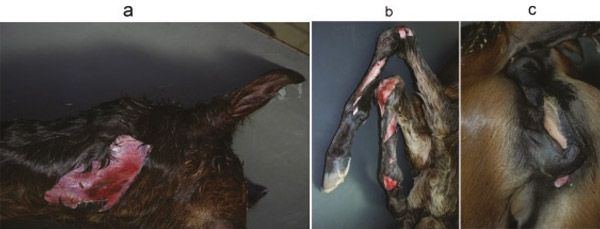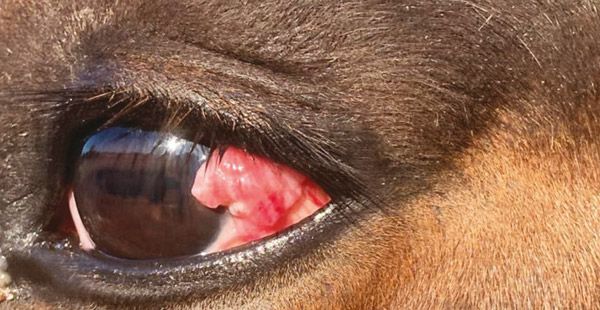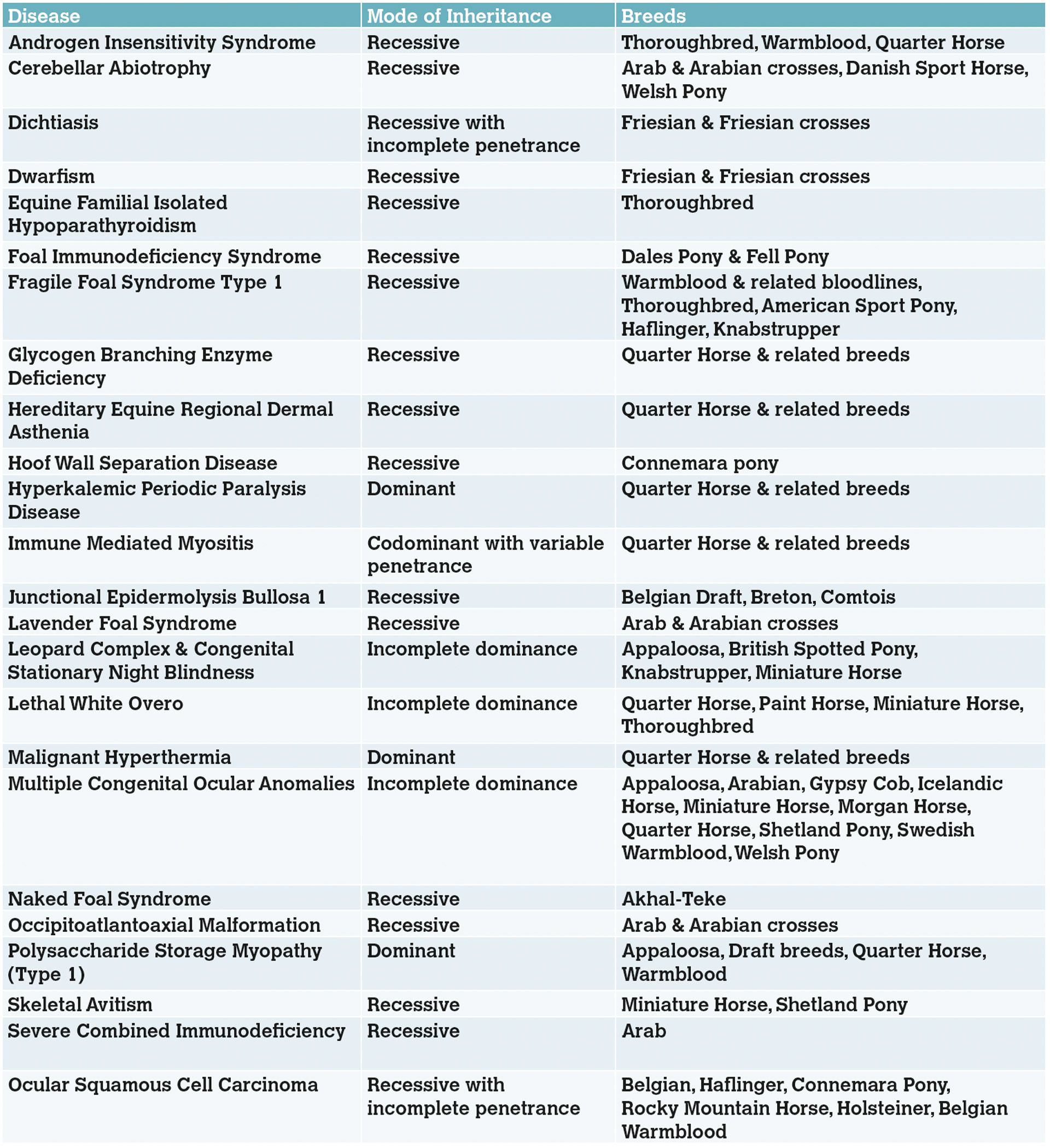UCD Research - July 2021
Role of vet in equine genetic disease testing
The field of equine genetics has rapidly advanced in recent years, with an ever-increasing number of genetic tests becoming available for use in horses. Nonetheless, there appears to be a hesitancy in the equine industry to adopt new genetic tools
In association with

Áine Rowe MVB
Resident in Equine Internal Medicine, University College Dublin, Belfield, Dublin 4, Ireland
Emmeline Hill
PhD, Professor in Equine Genomics, School of Agriculture and Food Science, University College Dublin, Belfield, Dublin 4, Ireland and Chief Science Officer, Plusvital Ltd, Ireland
Vivienne Duggan
MVB, PhD, Dipl. ACVIM, Dipl. ECEIM, Associate Professor Equine Clinical Studies, School of Veterinary Medicine, University College Dublin, Belfield, Dublin 4, Ireland
Lack of awareness of genetic disease has been cited as one of the major barriers to genetic testing. Knowledge of the genetic variants a horse carries for disease traits allows for informed breeding and management decisions. Veterinarians have an important role to play in facilitating the translation of knowledge gained through advancements in genetic tools into an improvement in the health and welfare of horses.
Rapid advancements in genetic technologies
The basis for equine genetic testing was initiated in the 1960s with the use of blood group markers for parentage analysis; these were replaced by DNA markers in the late 1990s. In the 1990s, new molecular techniques led to the discovery of the first coat colour variant (chestnut) in horses and the genetic basis of hyperkalemic periodic paralysis (HYPP), the first equine genetic disease for which the mutation was identified.
The sequencing of the genome of a Thoroughbred mare, Twilight, completed in 2007, paved the way for rapid advancements in the field of equine genetics, including the development of new technologies that allow for rapid screening of hundreds of thousands of genetic variants across horse genomes. These new genomic technologies have led to the discovery of the genetic basis of many equine diseases, including Hoof Wall Separation Disease in Connemara ponies.

Figure 1: Skin defects on the head (left), front legs (centre) and ventral to the vulva (right) in a foal affected by FFS. Images courtesy of Dr. Christine Aurich.

Figure 2. Limbal ocular squamous cell carcinoma.
As well as for clinical diagnostic purposes, genetic testing can be used for the identification of performance traits which, when understood alongside non-genetic factors such as environment and training, can assist with the optimisation of athletic ability. Genetic testing of equine embryos was first reported in 2010 and is commercially available for sex, coat colour and genetic disease. Genetic variants for many complex genetic diseases, in which the environment and genetics contribute to the phenotype, have also been identified. For example, genetic risk factors have been identified for equine metabolic syndrome (EMS) in Arabian breeds, ocular squamous cell carcinoma and equine recurrent uveitis, all of which have a significant welfare implication.
Genetic testing is being increasingly used in human medicine to provide personalised and preventative medicine; a practice described as ‘precision medicine’. Precision medicine focuses on patient-specific genetic and environmental factors, enabling an individualised health approach for early disease diagnosis and targeted, efficient treatment of disease. While precision medicine utilising genomics has grown rapidly in human medicine, particularly oncology, the concept is relatively new in veterinary medicine. Nonetheless, the translation of new genetic technologies into clinical diagnostics and therapeutic agents of clinical utility holds huge promise for the future.

Table 1: Equine genetic diseases for which genetic tests are currently available.
Fragile Foal Syndrome in horses in Ireland
Fragile Foal Syndrome (FFS) is a disease in which the inheritance of two copies of a mutation in the PLOD1 gene results in the birth of non-viable or still born foals with skin lesions. Flexural deformities, deformities of the spinal canal, perforating lesions of the aorta, open abdomen and small intestinal eventration are also described. The homozygous FFS genotype is incompatible with extra uterine life and foals are born dead, die or require euthanasia on humane grounds shortly after birth. No abnormalities have been reported with the heterozygous genotype.
Recent UCD research screened for the presence of the Fragile Foal Syndrome (FFS) gene variant in sport horses and Thoroughbred horses in Ireland. There was a low frequency of the FFS causative mutation in sport horses (1.98 per cent) and Thoroughbreds (2.75 per cent). Nonetheless, the presence of the mutation in the Irish horse population highlights the importance of genetic testing for the disease to identify phenotypically normal heterozygous carriers and to prevent both the dissemination of the allele and the birth of nonviable foals.
Barriers to genetic testing
Despite the increased availability of genetic testing, the equine industry has shown hesitancy in the adoption of new genomic tools. The obstacles to adoption of new genetic knowledge are not fully understood. A recent survey of horse owners in the US highlighted a positive association between genetic knowledge and the likelihood to genetically test. Lack of requirements for breed registration and lack of genetic disease knowledge were identified as the main barriers to genetic testing. Furthermore, some breeders believe that genetic testing represents an economic threat to their business and sport.
Surveys of practitioners in human medicine highlight a self-declared lack of genetic knowledge and training and a perceived low relevance to daily practice as major barriers to the use of genetic testing. Whether similar barriers exist among Irish horse owners and veterinary practitioners is unknown.
Veterinary involvement in genetic disease testing
As genetic components to many equine diseases are discovered and new genetic tests become available, it is important that veterinarians are comfortable discussing and advising on genetic disease testing.
Knowledge of breed-related genetic disease enables informed breeding and management decisions. When it comes to such decisions, usually veterinarians are not involved until after the birth of an affected foal or the onset of clinical signs of disease. However, in a recent survey, 65 per cent of horse owners wanted to receive further education on genetic disease, with almost one in five wanting to receive this information through conversations with their veterinarian.
There is much opportunity for future veterinary involvement in new equine genetic developments. Identification of horses at risk of complex genetic disease, which in some cases may be modified by the environment and management, would allow for more frequent veterinary assessment, permitting earlier diagnosis and treatment of disease and an opportunity to improve the prognosis of some conditions. Furthermore, pre-emptive environmental modification, such as dietary modifications or the wearing of a hood in the case of horses at increased risk of equine metabolic syndrome or ocular squamous cell carcinoma respectively, could reduce expression of the disease phenotype and markedly improve equine health and welfare. There is much research ongoing into complex equine genetic disease traits and it is likely that genetic testing for such traits will become commercially available in the future.
Currently, there are many laboratories offering genetic tests for inherited diseases in horses. While the recent Consensus Statement on the Translation and Application of Genomics in the Equine Industry, published by international experts in horse genomics, stated that genomic research should be reproducible, peer reviewed, ethical, and differentiate between scientific developments, commercial opportunity and opinion, there is no governing body so far established to approve genetic tests offered by laboratories. Patent-protected tests, not published in the scientific literature, can be commercially offered, with no information provided regarding test validation. Therefore, it is important that veterinary clinicians and researchers evaluate the process by which the data was validated so that horse owners can be best advised on the most appropriate use of genetic testing.
Future Directions:
The Consensus Statement on the Translation and Application of Genomics in the Equine Industry stated the importance of providing industry stakeholders with the appropriate information so that scientific developments can be translated into practice. At a recent meeting of the International Equine Genome Workshop, the need for formal stakeholder engagement in the translation of genetic tests in practice was highlighted.
To contribute to this need, researchers at the University College Dublin School of Veterinary Medicine, will shortly be conducting a survey into industry stakeholder opinions and perceptions on genetic testing for equine health and disease. The survey aims to identify participants’ perceived knowledge of equine genetic disease and genetic testing availability and determine the reasons for the current use of genetic testing of horses. In doing so, and through analysing associations between various demographic factors and perceptions of genetic testing, the researchers aim to identify industry-perceived barriers to equine genetic testing. It also aims to establish the opinions of industry stakeholders regarding the future use of genetic testing of horses. The research results will be used to improve stakeholder engagement, and educational outreach, including for veterinarians, as well as to enhance the understanding of the potential for genetic testing in the equine industry to positively impact on animal health and welfare.
References available on request.

Figure 3: Various quantitative structure-activity relationship tools are now used to analyse the structure of therapeutically relevant molecules based on a dataset of molecular descriptors. Such studies can provide an in-depth understanding of which molecular attributes contribute to the studied effect with a thorough comprehension of the mechanisms driving such phenomena (representative image). Photo: Sourav Bhattacharjee.
In association with

Áine Rowe MVB
Resident in Equine Internal Medicine, University College Dublin, Belfield, Dublin 4, Ireland
Emmeline Hill
PhD, Professor in Equine Genomics, School of Agriculture and Food Science, University College Dublin, Belfield, Dublin 4, Ireland and Chief Science Officer, Plusvital Ltd, Ireland
Vivienne Duggan
MVB, PhD, Dipl. ACVIM, Dipl. ECEIM, Associate Professor Equine Clinical Studies, School of Veterinary Medicine, University College Dublin, Belfield, Dublin 4, Ireland
















